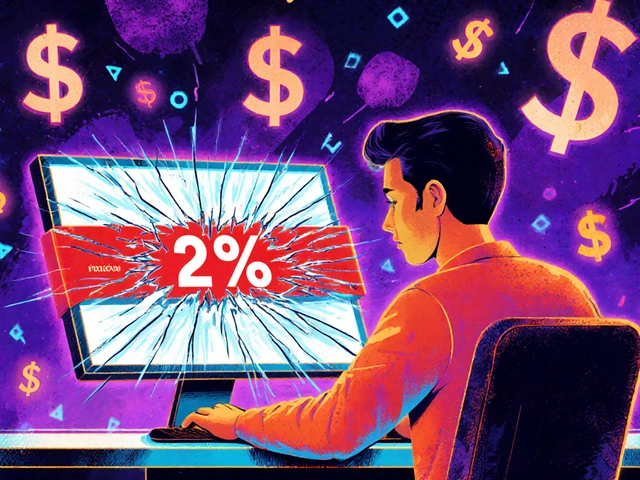Sentiment-to-Price Predictor
How Sentiment Predicts Market Moves
Based on article data: Sentiment scores correlate with price movements at 0.65-0.78 over 3-5 days. Enter your sentiment score (-1 to 1) to see the expected price movement range.
Every morning, markets react before anyone has a chance to read the news. Stocks jump on a single tweet. Bonds dip because of a CEO’s tone in a conference call. Traders don’t just watch earnings reports anymore-they watch how those reports are written, spoken, and shared. That’s where sentiment analysis comes in.
What Sentiment Analysis Actually Does
Sentiment analysis isn’t magic. It’s code that reads text-tweets, news headlines, earnings transcripts, Reddit threads-and guesses how people feel. Is the mood upbeat? Angry? Nervous? The system doesn’t understand emotion like a human does. Instead, it counts words, detects patterns, and assigns scores. A phrase like “this product is a game-changer” gets flagged as positive. “Total disaster after update” gets tagged as negative. Modern tools use deep learning models like BERT, trained on millions of financial texts. These models don’t just look for happy or sad words. They catch sarcasm (“Oh great, another price hike”), context (“Apple’s stock is down, but the new chip is brilliant”), and even implied intent. A customer saying “I might not renew” isn’t just negative-it’s a churn signal.Why Wall Street Cares More Than Ever
Traditional financial analysis looks at balance sheets, revenue growth, P/E ratios. Those are backward-looking. Sentiment analysis is forward-looking. It picks up shifts in mood before they show up in price charts. In March 2023, Moody’s AI systems flagged growing anxiety in regional bank news stories 37 hours before stock prices started falling. That wasn’t luck. The model noticed rising use of words like “collapse,” “liquidity,” and “regulators” in articles that previously focused on “growth” and “expansion.” Studies show sentiment scores correlate with stock moves at 0.65-0.78 over 3-5 days. That’s stronger than many technical indicators. Hedge funds like AQR Capital now spend 12% of their research budget on sentiment tools. Sixty-three of the top 100 hedge funds have dedicated teams just for this.How It Works Behind the Scenes
There are three main ways AI reads sentiment:- Rule-based systems use word lists. Words like “profit” = +8, “loss” = -7. Simple, but brittle. It misses “not bad” or “surprisingly good.”
- Machine learning models are trained on labeled data-thousands of articles tagged by humans as positive, negative, or neutral. These get 80-90% accuracy on standard tests.
- Aspect-based analysis digs deeper. Instead of just saying “the phone is bad,” it finds: “battery life = negative, camera = positive, software = neutral.” This is gold for product teams.

Real-World Tools and Costs
You don’t need a billion-dollar fund to use sentiment analysis. Options range from enterprise platforms to affordable SaaS tools.- Bloomberg Terminal and Reuters Eikon offer built-in sentiment dashboards. Cost: $24,000-$36,000 per year per user. Used by banks and hedge funds.
- Mentionlytics and Brand24 focus on social media and news. Cost: $299-$999/month. Popular with retail investors and smaller firms.
- Open-source tools like Hugging Face’s transformers let you build your own model. Free, but requires Python skills and data science time.
Where It Fails (And Why You Shouldn’t Trust It Alone)
Sentiment analysis isn’t perfect. It’s a tool, not a crystal ball.- Sarcasm trips it up. “Great job, guys. Another $50 million loss.” The model sees “great” and calls it positive.
- Cultural context matters. “Cool” can mean approval in the U.S., but indifference in Japan.
- Low-resource languages (like Thai or Vietnamese) drop 25-30% in accuracy.
- Market noise floods systems during volatility. During the March 2022 crypto crash, false signals caused a 12% error rate in trading bots.
Who’s Using It-and Who’s Falling Behind
Adoption is exploding. In 2020, only 22% of S&P 500 companies used sentiment tools. By 2024, it was 67%. For financial institutions? 89%. Retailers use it to track product reactions. Tech firms monitor forums for bug reports. But finance leads the pack because sentiment moves markets faster than earnings reports. A 2023 Capterra survey found 79% of financial analysts consider sentiment analysis “essential.” But 63% said it took 3-6 months to tune the model for their specific market. That’s the hidden cost: time. You need analysts who understand markets and data scientists who understand models. They have to work together.
What’s Next? Multimodal and Dark Pools
The next wave isn’t just text. It’s voice, tone, and video. Microsoft’s Dynamics 365 now integrates sentiment from earnings call audio. If a CEO’s voice cracks when saying “guidance,” the system flags it. Harvard Business Review found combining text + audio improved prediction accuracy by 31%. Even more advanced: dark pool sentiment. These are private trading networks where big players move huge volumes without public disclosure. Twelve major banks are testing AI that reads chat logs from these systems. If five institutions suddenly mention “Fed rate hike” in private messages, the model predicts a market move before anyone else knows. The SEC is watching. In February 2024, they issued new guidance: firms using sentiment for trading must document how their models are validated. That’s a sign this isn’t a fad-it’s becoming regulated infrastructure.Getting Started Without Getting Lost
If you’re new to this, here’s how to begin:- Start with one data source: Twitter feeds or financial news (like Bloomberg or Reuters free headlines).
- Use a simple tool like Mentionlytics or Hugging Face’s free sentiment API.
- Track one asset: a stock, crypto, or ETF you follow.
- Compare sentiment trends with price movements over 30 days. Do negative spikes precede drops?
- Build a custom word list for your asset. Add terms like “insider selling,” “short interest,” “institutional buying.”
Final Thought: It’s Not About Replacing Analysts
AI doesn’t replace traders. It gives them superpowers. The best investors now combine fundamentals, technicals, and sentiment. They don’t trust one signal. They triangulate. Sentiment analysis turns emotion into data. And in markets, emotion is the most powerful driver of all.Can sentiment analysis predict stock prices accurately?
Sentiment analysis doesn’t predict exact prices, but it can signal upcoming moves. Studies show a 0.65-0.78 correlation between sentiment shifts and stock price changes over 3-5 days. It’s a leading indicator, not a crystal ball. Used alone, it generates false signals-especially during market stress. Best results come when combined with fundamentals and technical analysis.
Is sentiment analysis only for big hedge funds?
No. While Bloomberg and Reuters tools cost tens of thousands per year, affordable options like Mentionlytics start at $299/month. Open-source tools like Hugging Face are free. Retail investors can start by tracking sentiment on Twitter or news headlines for one stock. The key is learning to interpret the data, not buying the most expensive tool.
Why do sentiment tools misread financial terms?
General-purpose models are trained on everyday language. Financial terms like “bullish,” “short,” or “earnings beat” don’t always match common usage. “Short” can mean negative in casual speech, but in finance, it’s a strategy. Without custom lexicons built for finance, tools misclassify these terms-especially during earnings season. Top users spend months fine-tuning word lists.
How does sarcasm affect sentiment analysis?
Sarcasm reduces accuracy by 15-20%, according to Thematic’s 2024 benchmark. Phrases like “Oh, great, another delay” are flagged as positive because “great” is a positive word. Advanced models like BERT are better at context, but still struggle. This is why human review is still needed-especially for critical decisions.
What’s the difference between sentiment analysis and market research?
Market research collects data through surveys and interviews-structured, intentional. Sentiment analysis pulls unstructured data from public conversations: tweets, news, forums. It’s passive, real-time, and reflects organic public mood. One asks people what they think; the other listens to what they’re already saying.
Are there regulatory risks with using sentiment analysis?
Yes. In February 2024, the SEC required firms using sentiment analysis for trading to document how their models are validated and tested. This affects 73% of quant funds. If you’re using sentiment to make trades, you need to prove your system isn’t biased, overfit, or based on unreliable data. Ignoring this could lead to compliance issues.






Comments
Look, sentiment analysis is just quantifying the emotional noise of a hyperconnected, dopamine-addicted hive mind. The models aren't reading intent-they're counting keywords like a toddler with a thesaurus. 'Bullish' gets flagged as positive? Duh. But in finance, 'bullish' means 'I'm buying before the herd stomps in.' The real edge isn't in the algorithm-it's in knowing which jargon is performative and which is structural. Most firms treat this like a magic wand, but it's just another layer of noise in a system already drowning in data.
Oh wow, another ‘AI is the future’ brochure. Let me guess-someone at Bloomberg slapped a BERT model on their dashboard and now they’re calling it ‘alpha.’ Newsflash: if your sentiment model can’t tell the difference between ‘this stock is a dumpster fire’ and ‘I’m so excited to short this dumpster fire,’ you’re not trading-you’re playing Wordle with other people’s money. And don’t even get me started on ‘dark pool chat logs.’ You think hedge funds are whispering ‘Fed rate hike’ in private Slack channels? Nah. They’re just copying Bloomberg headlines and pretending they’re insider intel. Pathetic.
I’ve been testing a simple sentiment tracker on Tesla’s Twitter feed for three months. Negative spikes do tend to precede dips, but only when volume surges. Quiet negativity? Usually noise. Also, ‘earnings beat’ being flagged as negative because ‘beat’ isn’t in the lexicon… that’s embarrassing. I added 47 finance-specific terms manually. Took weeks. Worth it. The tool isn’t broken-it’s just lazy. Human tuning isn’t optional. It’s the difference between a compass and a broken GPS.
Y’all are overcomplicating this. I started with Hugging Face + Twitter for Bitcoin. Just tracked ‘FOMO,’ ‘dump,’ ‘diamond hands,’ ‘paper hands.’ Within two weeks, I saw patterns-when ‘diamond hands’ spiked after a 10% drop, price bounced 72% of the time. No fancy models. No $30k terminals. Just me, a spreadsheet, and a lot of coffee. Sentiment isn’t about AI-it’s about listening to the people who actually trade. The market’s not a spreadsheet. It’s a crowd. And crowds talk in memes, not metrics. 🤓
Thank you for this clear breakdown. I tried using Brand24 for Indian market sentiment but kept getting false positives on words like ‘crash’ and ‘fall’-they were used in spiritual contexts, not finance. Custom lexicon helped. Small step, but meaningful. 🙏